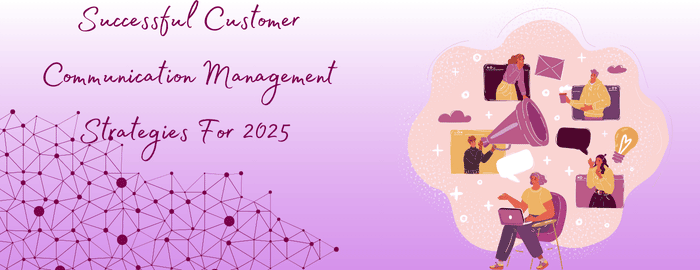Top 5 Customer Communications Management (CCM) Strategies: Transform Business-Customer Relationships into Meaningful Connections

Did you know that 79% of consumers are willing to switch to a different organization if it can provide them with better customer experiences? Now, this obviously means that customer experience is a key differentiator in the market, more so than earlier. With so many different companies, customers have many options, and it won’t take long for them to switch to a competitor because of negative CX.
Want to explore what customer communication management and how it can reshape your customer experience? Click here to read about its history, best practices in CCM, and more!
Today’s customers aren’t like those of the past; with just a click of a button or a mouse, they have access to all your competitors and everything they offer. This is why your customer service needs to be outstanding, not just to prevent losing customers but also to ensure the brand’s long-term sustainability. Sounds like hogwash? But not really, let’s look at more statistics. According to Forrester’s CX rankings, customer-obsessed organizations reported 41% faster revenue growth than non-customer-obsessed organizations. The report also stated that Customer-obsessed organizations reported 51% better customer retention than their counterparts.
Utilizing a customer communication management strategy centred on customers and their needs helps businesses tailor communications to specific audience requirements. If this isn’t enough to convince you, maybe what you read next might.
Actionable Takeaways
- Audit your current communication touchpoints for consistency.
- Segment your audience and test personalized messaging.
- Leverage AI and the latest tech to enhance your communication strategy.
- Adopt omnichannel platforms that centralize communication.
- Build feedback mechanisms into your customer journey.
- Review compliance protocols regularly.
Customer communication management plays a vital role in enhancing customer experiences. A software that can work more efficiently and accurately than humans, encompassing CCM strategies, technologies, and processes. Basic messaging systems are now obsolete. Instead, organizations align their customers’ preferences with business objectives to deliver personalized, consistent, and contextually relevant interactions– a strong customer communication management strategy.
In the wise words of Stewart Butterfield, Co-founder of Slack, “Every customer interaction is a marketing opportunity. If you go above and beyond on the customer service side, people are much more likely to recommend you.”
The challenges in customer communications are very real. From inconsistent messaging to personalizing interactions at scale, organizations struggle to make do with customer communications. Unfortunately, these hurdles create barriers to effective customer relationship management communication.
Modern CCM platforms incorporate the latest technologies and strategies, such as AI, ML, automated workflow management, and more. These strategies help transform standard communication approaches into strategic assets.
Let’s explore the pivotal strategies of 2025!
To learn more about the latest tools used in this domain, check out our detailed blog on customer communication management software.
Personalization: Understand Your Customers and Address Them Directly
Customers want more than just a measly name on their email. They want tailored experiences. They want convenience. So businesses create personalized communication strategies that enhance engagement.
Why Does it Matter?
A Deloitte Digital report reveals that brands focusing on personalization are 71% more likely to report improved customer loyalty. When customers receive communication that aligns with their interests, preferences, or behaviour, they are more likely to respond or interact with the content.
How To Implement Effective Personalization Strategies
Data-Driven Customer Segmentation: To use your customer data effectively, start by segmenting your audience based on demographics, behaviours, or past interactions.
Dynamic Content Generation: When organizations implement dynamic content frameworks to automatically tailor communications based on real-time data, for instance, an email that recommends products based on previous purchases while ensuring compliance with regulations.
Contextual Engagement: Deploying communication that shows the customer’s position in their journey. A good example of this would be in the insurance industry, whether customers are researching options, evaluating renewals, or navigating a claims process. This is particularly relevant in insurance customer communication management.
Tone and Timing: Effective communication means getting the timing right. So, business users adjust communication timing based on email open rates and other factors. Tone also plays a crucial role, welcoming new users warmly, being concise for loyal customers, and empathetic in critical cases. For each of these, the tone must vary accordingly.
Personalized Follow-Ups: When a customer completes a purchase, sending personalized follow-up messages is no different from a reminder that says, ‘You may have finished your purchase, but we still care.’ A simple thank-you message for purchases, a discount code as a loyalty incentive, or even a suggestion of related services that would assist them can be the striking difference between a satisfied and a loyal customer.
Discover the measurable value of these approaches by reading about the benefits of customer communication management and how it drives business growth.
Omnichannel Strategies: Leverage Multiple Channels to Meet Your Customers Where They Are
Customers want interaction on different channels, resulting in the development of omnichannel communication frameworks. This isnt a luxury that customers want but rather a necessity in this digital era.
Why Does it Matter?
A Forrester study reported that 43% of organizational leaders say that creating omnichannel experiences is one of the most challenging tasks in improving customer experience, and 43% also say that customer demands for omnichannel experiences have increased. Of course, it is a challenge, but one that organizations must tackle head-on.
How To Implement Cohesive Multichannel Strategies
Channel Preference Mapping: You can conduct surveys or analyze how customers want to be contacted and when. Determining and focusing on their preferred channel allows for targeted, timely engagement, which is a key step in any effective customer communication management strategy.
Consistency Across Channels: It’s very important that brands maintain consistency in terms of messaging, interface, or design, adapting for specific channels. This includes using similar visuals, tone, and branding elements to create a unified experience is essential to a successful customer communication management strategy
Communication Integrated Tools: Connecting a CRM platform, email marketing tools, and customer support system with your CCM tool would work wonders on your CX.
Regulatory Compliance: The evolving governing regulations need a governance framework to ensure all outbound and inbound communications, regardless of channel, maintain compliance with relevant regulatory requirements.
The Rise of Automation with a Human Touch in Customer Experience
Automation can scale communications, but without the human touch of personalization, it can come across as robotic and banal. It can enhance customer satisfaction by figuring out the right balance between the two and incorporating it into your customer communication management strategy. AI can help nurture leads, reduce response times, and keep customers informed, all without overworking your employees.
Why Does it Matter?
A Zendesk report found that 68% of consumers trust AI agents that exhibit human-like traits more. A PwC Global CEO Survey mentions that 70% of global CEOs opine that generative AI will significantly change how their companies deliver and capture value within the next three years. AI doesn’t just enhance CX but can also effectively increase revenue.
How To Implement Automation in Customer Communications
AI Chatbots for Customer Support: Using chatbots on your website or application enhances response time. More importantly, it can take on basic inquiries, only routing to agents for complex issues, improving agent productivity as well.
Automated Email Campaigns: Setting up automated email campaigns whenever a customer onboards, sending reminders and follow-ups, and more.
Trigger-Based Messaging: Business users can set up automated workflows for onboarding, cart, abandonment, or support ticket updates.
Sentiment Analysis: With sentiment analysis tools, organizations can gauge customer emotions and feedback and provide valuable insights. By monitoring social media, reviews, and direct interaction, business users can make proactive adjustments to communication strategies.
Customer-Centric Communication: Feedback-Driven Engagement Strategies
Good communication is a two-way street, so it is crucial for organizations to gather and act appropriately on customer feedback. A comprehensive customer communication management strategy takes customer feedback seriously, strengthens trust, gives the customer the impression that you genuinely care, and helps your organization identify areas for improvement.
Why Does it Matter?
Did you know? 56% of consumers rarely complain about a negative customer experience—they quietly switch to a competitor instead. A feedback loop gives companies an opportunity to address their problems and customer pain points.
How To Implement Feedback-Driven Communication
Centralized Feedback Channels: The first step is to gather feedback from various sources and consolidate it under one platform. You can use tools like Google Forms or SurveyMonkey to distribute it easily after customers complete their purchases.
Analyze for Trends and Insights: The second step would be to leverage analytical tools to process large volumes of data, identifying recurring keywords, themes, and sentiments. Tools like SurveySparrow also offer customer feedback analysis.
Timely Execution of Insights: It loses effectiveness if there is a delay between identifying and addressing an issue. Organizations need to communicate the feedback to the right stakeholders so they can act on it.
Monitor Social Media: Today, if a customer is unhappy, they will post about it online. This means any number of people could see it. Organizations must track and engage with users who mention the brand, showing that they value customers’ opinions and gain real-time insights.
Compliance and Security: An Essential Customer Communication Management Strategy
We always hear about building trust with customers, but how do we do it? With increasing and evolving regulations and customer concerns, organizations must be transparent and prioritize data security. Security and compliance considerations must be embedded within your customer communication management strategy to protect customer data and maintain trust.
Why Does it Matter?
Zendesk Benchmark Data mentions that 70% of consumers won’t purchase a product or service from a company they view as having lackluster security measures. 56% of CX leaders admit their organization experienced a data breach or cyber attack targeting customer data in the past year. Considering the staggering statistics, it’s evident that investing in security and compliance is necessary to avoid legal penalties and prevent reputational damage.
How To Implement Secure and Transparent Communication
Data Protection: Organizations should ensure that all inbound and outbound communication aligns with industry standards. More so in heavily regulated industries like insurance or banking, for example, insurance-related organizations should adhere to GDPR, HIPAA, and other regional laws.
Secure Channels: Any communication or interaction should happen on end-to-end encrypted channels or portals to ensure confidentiality and security for sensitive information.
Regular Security Audits: Conduct routine assessments to identify gaps or vulnerabilities in your communication process. Of course, it includes evaluating your software and hardware components to stay ahead of potential threats.
Train Your Employees: Organizations should invest time and money in training their employees to spot potential security risks. Equipping them with skills and knowledge of compliance practices ensures they know the latest security threats and best practices to handle customer data.
For deeper insights on the latest innovations in CCM, explore our post on customer communication management trends.
How to Measure Communication Effectiveness and ROI
Measuring communication effectiveness is a critical part of refining your customer communication management strategy. Organizations that implement CCM strategies must check and see if their methods are yielding the desired results or not. They must develop comprehensive measurement frameworks that evaluate performance and demonstrate return on investment. These frameworks should include both quantitative metrics and qualitative feedback to provide a holistic view of communication effectiveness.
Key Performance Indicators for CCM
Engagement Metrics: Organizations should track open rates, click-through rates, response times, and channel interaction patterns.
Conversion and Resolution Metrics: Measure whether communications are fulfilling their purpose; for instance, are policies being renewed? Additionally, you need to evaluate issue resolution rates.
Customer Satisfaction Indicators: Listen to your customers! Start implementing targeted surveys, Net Promoter Score Tracking, and sentiment analysis to understand how customers perceive your efforts to enhance communication and engagement.
Operational Efficiency: The CCM strategies you have implemented must be evaluated after a particular period to check their impact on operational performance. Some metrics you can use are average handling time, cost per communication, and staff productivity.
Practical Steps to Implement an Effective Customer Communication Management Strategy
Organizations interested in implementing CCM strategies should follow the approach below:
- To identify gaps and engagement opportunities, start with a communication audit to evaluate your organization’s current communication touchpoints, effectiveness, and compliance processes.
- Develop a customer-centric communication framework, focusing on messaging guidelines, regulatory requirements, and engagement best practices.
- Once you know where you stand and have worked on specific customer communication management strategies, you must select and deploy a CCM platform that meets your organization’s requirements based on your initial assessment.
- It is crucial that marketing, compliance, customer service, and IT departments collaborate to ensure the development of cross-functional communication.
- Once the solution has been implemented, stakeholders should regularly review performance data and customer feedback to refine communication strategies.
Conclusion
Customer expectations constantly evolve, and we’ve seen how the 21st century and its development have transformed the digital landscape. Likewise, the same customers who have witnessed the transformation wouldn’t settle for anything less. We’ve already established that CCM is the key to CX in 2025. An effective CCM strategy blends technology, empathy, and insight. It’s not just about sending more messages, but the right messages at the right time in the right way.
These strategies offer a roadmap to meaningful and productive customer relationships. However, although these strategies serve as a starting point, the best approach is to view CCM as an ongoing journey. A long journey that requires periodic refinement and innovation, continuously adapting and leveraging new technologies to address customer expectations and regulatory requirements.
FAQs
Customer Communication Management is a strategic approach that reflects current customer communication management trends. Organizations utilize CCM systems to create, deliver, store, and retrieve customer communications. The aim is to enhance customer experience (CX) and improve business outcomes. Companies have recognized the impact that customer experiences have on business, including retention rates, sales, and the overall future of the organization.
A well-defined customer communication management strategy is crucial because it helps organizations improve customer engagement, increase retention rates, and drive revenue growth. It ensures that communications are aligned with customer preferences and business objectives, ultimately leading to better customer experiences.
Whether you are choosing or evaluating a customer communication management software, you should prioritize features like personalization engines, intelligent content management, data analytics, compliance management, omnichannel support, and scalability. These features help you address various communication challenges, while meeting the diverse customer needs and maintaining regulatory compliance.
A successful implementation means multiple departments (including customer service, marketing, sales, IT, finance, and human resources) must collaborate and work together to first finalize the requirements, then decide on a solution that meets their needs, and finally implement it in a phased approach.
The ROI can be witnessed in multiple areas, to name a few:
- Reduction in template management and production costs
- Improvement in customer retention rates
- Reduction in call center volume
- Reduction in compliance-related issues
Top 10 AI-based document generation software
Once merely a buzzword, “AI” has rapidly evolved into an indispensable component of our daily li
Creating a better customer experience with behavioral design
Today’s business world is very competitive, so companies must develop new ways to stand out fr
Best Email Design Size For Marketing Campaigns
Are you starting an irresistible marketing campaign but confused about what an ideal email design si




